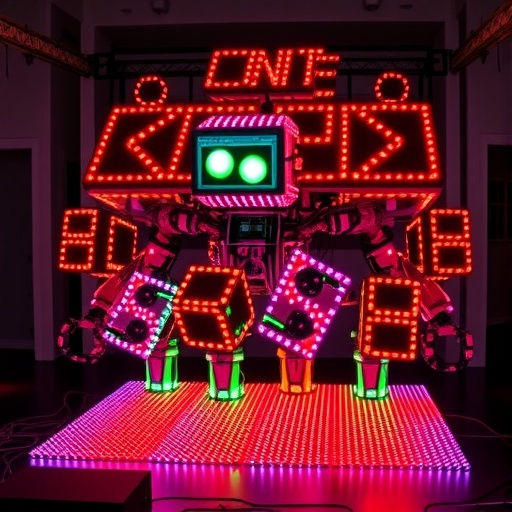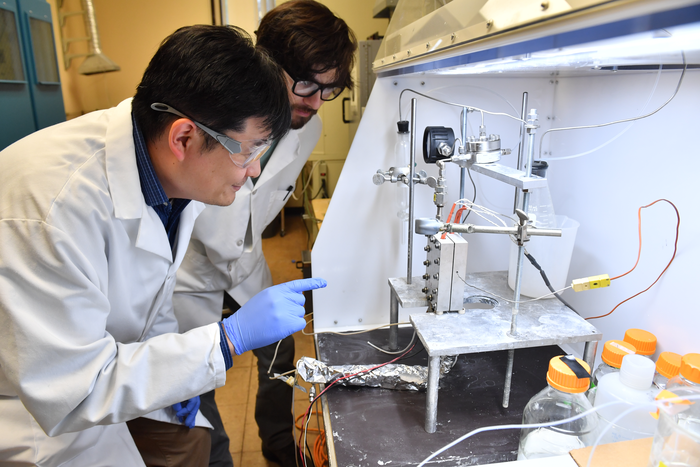
Researchers at North Carolina State University have made a significant breakthrough with the development of Rainbow, a pioneering multi-robot self-driving laboratory that represents a remarkable advancement in materials discovery. This innovative platform autonomously synthesizes high-performance quantum dots, which are semiconductor nanoparticles integral to the progress of next-generation technologies such as displays, solar cells, LEDs, and various quantum-engineering applications. By integrating state-of-the-art robotics with artificial intelligence, Rainbow can perform an astonishing 1,000 experiments each day, completely bypassing the need for human oversight and fundamentally transforming the speed and efficiency of scientific experimentation.
The underlying mechanics of Rainbow exemplify a sophisticated synergy between automation and intelligence. The robots within the laboratory are engineered to prepare chemical precursors, mix them, and execute a myriad of reactions in parallel within miniaturized batch reactors. This system’s inherent capability allows it to process as many as 96 reactions simultaneously, elevating the throughput of materials discovery to unprecedented levels. Furthermore, all reaction products are automatically channeled to a characterization robot that meticulously analyzes the outcomes, enabling a fully automated and intricately coordinated workflow.
The operational paradigm of Rainbow starts with user-defined parameters, wherein researchers specify target material properties such as emission wavelength or bandgap, along with an experimental “budget”—the number of experiments Rainbow should conduct before it ceases operations. Once these parameters are established, Rainbow employs real-time optical characterization and machine learning algorithms to intelligently evaluate results and determine subsequent experiments in its quest for optimal nanocrystal formulations. The profound efficiency of this autonomous lab lies in its ability to autonomously innovate its synthesis recipes, enhancing the energy conversion efficiency from input to desired output.
As stated by Milad Abolhasani, the ALCOA Professor of Chemical and Biomolecular Engineering at NC State and lead author of the research paper detailing Rainbow, this system does not aim to replace human researchers but rather to empower them. By managing the monotonous and time-consuming tasks associated with experimental procedures, Rainbow frees scientists to concentrate on design and innovation, ultimately advancing the frontiers of material science.
Abolhasani, recognized as a leader in the realm of self-driving laboratory technologies, notes that the robotic architecture of Rainbow marks a notable deviation from earlier projects. The interoperability of multiple robots conducting experiments across different batch reactors allows a more extensive exploration of diverse precursor chemistries, significantly broadening the scope of possible outcomes. This flexibility provides researchers with an unparalleled opportunity to discover the highest quality quantum dots, which are pivotal for the effectiveness of various high-tech applications.
In addition to synthesizing quantum dots, Rainbow’s sophisticated platform permits researchers to investigate various ligand structures that can be attached to these nanocrystals. Ligand configurations can profoundly influence the properties of the quantum dots produced, thus the ability to systematically explore these variations could yield breakthroughs in quantum dot function and utilization. With this multi-faceted experimental approach, Rainbow is not just enhancing discovery rates; it is also facilitating a deeper understanding of the fundamental science behind these materials.
Rainbow’s design also incorporates a critical aspect of scaling. Once the system identifies the optimal formulation for a desired quantum dot, it can seamlessly transition from using small-scale batch reactors intended for research purposes to larger-scale reactors suited for industrial manufacturing. This scalability is crucial for commercial applications, enabling the frictionless transition from laboratory findings to real-world production.
This remarkable technology has garnered attention for its speed and efficiency, offering a dramatic contrast to traditional methodologies that require human intervention and often unfold over extended periods. According to Abolhasani, what would typically take human researchers several years can now be accomplished by Rainbow within mere days. This game-changing capability is poised to redefine the timeline and approach to materials discovery, leading to potentially revolutionary advancements in multiple technological fields.
The research culminated in the publication of a paper titled “Autonomous multi-robot synthesis and optimization of metal halide perovskite nanocrystals,” featured in the prestigious journal Nature Communications. The lead author, Jinge Xu, along with co-authors including fellow Ph.D. candidates, postdoctoral researchers, and even undergraduate students at NC State, underscores a collaborative spirit that is emblematic of modern scientific endeavors.
Supporting this groundbreaking work were funds from the University of North Carolina Research Opportunities Initiative and the National Science Foundation, an investment in future technologies that promises to bear significant fruit in the coming years. The collaborative effort between diverse fields—robotics, AI, and chemistry—illustrates the potential for transformative discoveries when interdisciplinary approaches are applied in scientific inquiry.
The implications of Rainbow’s capabilities extend far beyond quantum dot synthesis. The integration of autonomous robotics and machine learning can lead to enhanced understanding and optimization across a variety of chemical reactions and materials applications. The ripple effects of this innovation may be felt in fields encompassing renewable energy, electronics, and beyond, highlighting the importance of advancing laboratory technology to match the pace of scientific inquiry.
In conclusion, the advent of Rainbow marks a pivotal moment in the realm of materials discovery. This sophisticated system exemplifies how the intersection of robotics, AI, and chemistry can redefine the landscape of scientific research. Rainbow’s unparalleled efficiency, scalability, and flexibility position it at the forefront of next-generation laboratories, actively participating in shaping the future of innovative materials and advanced technologies.
Subject of Research: Quantum Dots Synthesis and Optimization
Article Title: Autonomous multi-robot synthesis and optimization of metal halide perovskite nanocrystals
News Publication Date: 22-Aug-2025
Web References: Link to the article
References: None Required
Image Credits: None Available
Keywords
Robotics, Artificial Intelligence, Quantum Dots, Materials Discovery, Self-Driving Labs, Automation, Chemical Engineering, Nanocrystals, Synthesis, Advanced Materials, Interdisciplinary Research, Innovation
Tags: artificial intelligence in roboticsautomated scientific experimentationautonomous materials discovery platformefficiency in quantum-engineering applicationshigh-performance quantum dots synthesisminiaturized batch reactors for chemistrymulti-robot self-driving laboratorynext-generation technology advancementsparallel reaction processing in labsRainbow multi-robot systemrobotics and automation in materials sciencesemiconductor nanoparticles research






